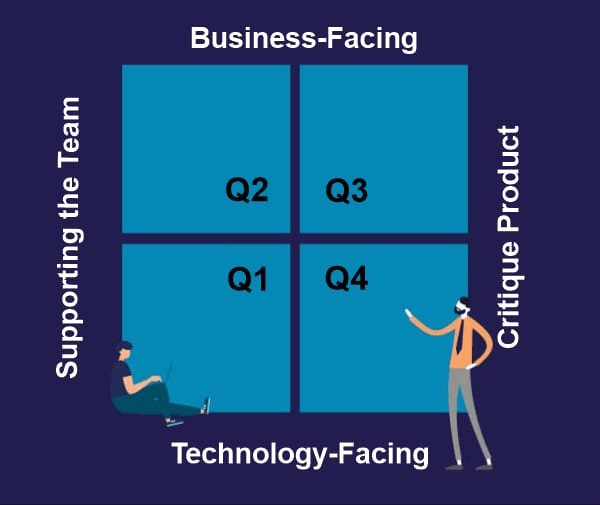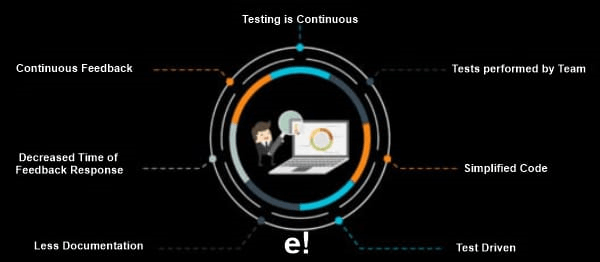Agile Testing Quadrants
Agile Testing Quadrants are types of visual tools that were founded by Brian Marick, which later Janet Gregory and Lisa Crispin worked upon.
Agile Testing is a tool that helps to understand the various quadrant tests. Through this process, we can simply understand the work and language of the testing process. This testing is defined as a new approach to software testing where the process is continuous as well as it has a very fine quality. Agile testing is divided into various categories and they are listed below;
- Quadrant one: This quadrant is concerned with the quality of the code and its components, which sees the involvement of developers along with the implementation of the technologies and automation. This quadrant is technology driven. In this quadrant, there is quick or instant feedback so that improvement can be made on the basis of the quality of the code. It also helps in the designing of the products.
- Quadrant two: Here business-driven test cases are being implemented for supporting the team. It involves the usage of both manual and automated testing along with various testing types like functional testing, story testing, prototypes and simulations, and many more. This quadrant mainly focuses on business requirements.
- Quadrant three: Here feedback and reviews of the previous testing phases or quadrants along with the real user experience, work as a driving force to test the software product using multiple scenarios. It gives the feedback of both the first quadrant and second quadrant.
- Quadrant four: This quadrant involves the usage of tools to automate the process of software evaluation at an operational acceptance level to fulfil non-functional requirements such as reliability, and security. Its main responsibility is to deliver the products.

Principle of Agile Testing
1. Business agility.
2. The Test-driven approaches.
3. Testing should be continuous.
4. Testing propels the project.
5. Continuous integration.
6. Testing as a best practice.
7. It has easy and simple codes.
Advantages of Agile Testing
Some of the advantages of agile testing are:
- It is customer satisfactory.
- It increases employees' productivity and satisfaction.
- It reduces the cost of fixing the process of bugs.
- It improves software quality.
- It increases profits and bigger market shares.
- It is a better time-to-market.
Disadvantages of Agile Testing
Some of the disadvantages are:
- It has poor communication with the teammates.
- It is not capable of performing a regression test.
- It is inflexible to the changing requirements.
- Inability to estimate the lead time.
- It lacks long-term planning.
- Only experts can work on the projects.
Methods of Agile Testing
The different agile testing methods are:
1. Test Driven Development (TDD):
TDD was first developed by Kent Beck in 2002. Here, tests are given first preference over functions as functions are not written before the test. This test makes small changes which help in quick or rapid iteration. After all the changes and additions are made the later process is to get the customer feedback after the shipment made of the product. TDD is quickly adopted by agile software developers for the development of application source code and is being adopted by agile DBAs for database development.
TDD helps in maintaining the quality of implementation, for its early issue discovery, no dead codes, rapid feedback and so on. It works on the bases of two steps and they are Behaviour Driven Development or BDD, and Acceptance Test-Driven Development also known as ATDD.
2. BDD(Behaviour Driven Testing)
BDD was first developed in 2009 by Dan North. It is a part of test-driven development or TDD. It acts as a bridge between the product management team and the software development team. It can be best described in the field of automation frameworks by engineers. The main focus is on the extended behaviour of the application and its components. The user stories are created and maintained by the stakeholders. Behaviour Driven Development or BDD helps in the developing features that add business values, it also defines the unambiguous requirements, executables, and verifiable.
Overall BDD can be defined as a discipline technique for building software in which the product owner, programmer, and tester collaborates on system behaviour.
3. Acceptance Test Driven Development (ATDD)
ATDD is a technique that defines accurate requirements. It focuses on defining acceptance criteria and having a simple native language. It is a part of agile methodology where automated tests are written with the help of user perspective. Unlike test-driven development where acceptance tests are created from the perspective of the developer. ATDD advocates automation tests from various perspectives of the users.
ATDD has several benefits and they are; it shares a common understanding of the problems, it shares the definition of DONE, it involves the whole team, it provides common language examples, it prevents defect, and it has a fast testing rate or we can say that it test at an API level, and many more.
4. Exploratory Testing
Exploring testing is a character that defines the exploration session of an application to search for bugs outside the existing test cases. Both the learning and testing activities are done in parallel. It improves the test case and the test designs. It helps in making decisions quickly or rapidly in a continuous process. In exploratory testing no test cases are required or performed to test the application but it helps in the designing process and exploring the application. It further identifies which action should be performed next.
5. Session-Based Testing
Session-based testing is a method where the testing of software with the combination of reporting and exploratory testing, takes place. So through this process one can easily find the defects, perform management control and collect metrics. Its main goal is to test the unit. Session-based testing is of three types and they are; short sessions which last for 45 minutes, normal sessions which last for 1.5 hours and long sessions which last for 2 hours.
Difference between TDD, ATDD, and BDD
TDD
It is defined as an approach to development that focuses on the implementation of features.
It uses the testing language of a used programming language.
Its main focus is to test the unit.
It is suitable for projects that do not involve end users.
BDD
It is an approach of development that focuses on system behaviour.
It uses a simple native language.
It mainly focuses on understanding the requirements.
It is suitable for projects that are driven by the user's action.
ATDD
It is a technique that focuses on defining accurate requirements.
It uses a simple native language.
Its main focus is on defining the acceptance criteria.
It is suitable for projects where customer experiences are important and where competition is high.

Life Cycle of Agile Testing
The Agile life cycle is completed in five processes and they are:
1. Impact Assessment
It helps to gather the inputs from stakeholders and users that act as feedback for the next development cycle.
2. Agile Testing Planning
In the second stage of the agile life cycle, the stakeholders plan and schedule the testing process and deliveries.
3. Release Readiness
In the third stage, decisions are made on whether the features which are implemented are to be live or not. It also tells us whether the features from this stage should move to the previous stage or to the next.
4. Daily Scrums
In the fourth stage, morning meetings are included such that it meets the status of testing and further to set goals for the entire day.
5. Test Agility Review
In the fifth or last stage reviews are made such that they involve meetings weekly or regularly with the stakeholders. Weekly meetings are being held so that they should progress towards the goals.
Conclusion
Agile testing leads to testing in a rapid manner in the software development life cycle. It demands higher customer involvement. Agile testing makes communications between the team easier and it proves to be effective. In this testing process, regression testing can be done easily in order to check bugging. This method of testing has contributed substantially to a new understanding and a better way to build software. And in order to use this method companies need experienced staff so that the project will prove to be efficient as well as effective. An agile methodology can be used to satisfy documents that need mission-critical software development for the department of defence with some modification from its pure form. The customer interaction and its acknowledgement of the differing needs for documentation using Agile is key. Overall, it helps to deliver products faster with high quality and satisfy the customer needs through the application of the principle of production.